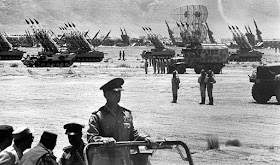With superior arms, the Egyptians raced toward Tripoli on the coast roads after bypassing Ajdabiya. The Libyan army looked for methods of ambush, but Egyptian air superiority kept enemy tanks and infantry pinned. On July 24, armed forces rolled into Tripoli, and Gaddafi was nowhere to be found. The leader of the revolution had pulled out of the capital and hidden in bunkers deep in the desert.
Algeria and Palestine called for an armistice, but their cries went unheard. Instead, Egypt called for free elections and a new Libyan government. As a fallen leader, Gaddafi was not arrested, merely ignored, and he would eventually become an expatriate in Syria. The new election was backed by the United States; most international figures merely sat back to watch. The USSR was expected to speak out, but the Soviets were quiet as they had their own designs on invasions farther east and hoped not to muddy international waters.
Libya, now newly reopened, fell in line with Egyptian ideals and developed relations with the West. Farther in the east, Iran would arise in a revolution to become a religious republic (what many called socialist). Saddam Hussein's government, suspicious of Ba'ath revolutionaries spilling over from Iran, declared war on their neighbor, which received increasing aid from the USSR despite their own problems in Afghanistan. Western attention was drawn more heavily to Libya, and Iraq would fall to the theocratic Iranians.
A new “iron curtain” would drop across the Middle East. Both sides would grow increasingly fearful of the other, and war seemed imminent daily. Terrorist attacks rang through Saudi Arabia, hoping to edge the king out of power, but further backing from Egypt and the West would keep the balance. After the fall of the Soviet Union in 1991, the eastern states would face economic collapse and sought to bring in Kuwait as a liberation of Arab resources from Western hands.
The Gulf War began with an invasion of Kuwait from the north, and a massive United Nations force would counter-invade with Egyptian and Saudi troops leading the way. War seemed to spin out of control, and it seemed unfathomable to end without bringing down the Iraqi and Iranian governments, which was achieved in 1994 with the Fall of Tehran. Coalition forces would stay behind in the region for decades to come, redrawing national borders to create Kurdistan and establishing constitutions based on ideals of freedom. Terrorism and insurgency would follow continually and plague the elected governments for generations.
–
In reality, Egypt did not fully counterattack Libya, and both countries were quick to agree to armistice. Algerian president Houari Boumediène mediated peace with the help of Palestinian Yasser Arafat. Though peace was achieved, the rift between conservative and socially revolutionary Middle Eastern states would continue.

No comments:
Post a Comment